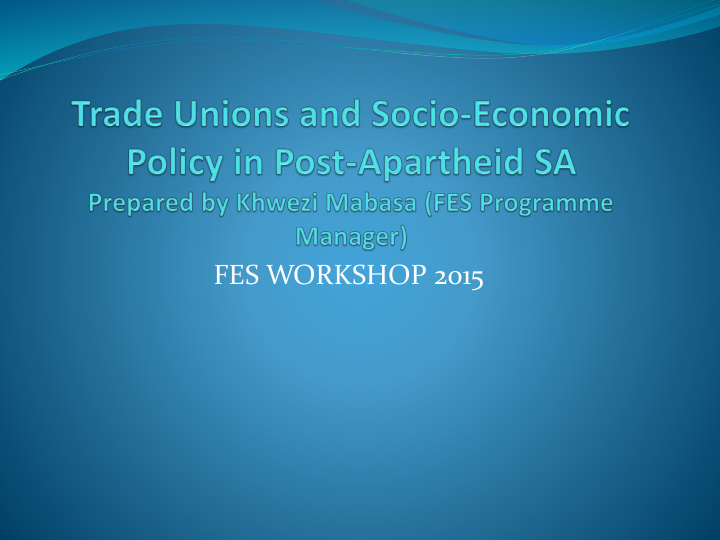



FES WORKSHOP 2015
Structure of the presentation Global and domestic political economy Key areas of socio-economic development in SA Important socio-economic policy trends in 2015 Policy advocacy and research gaps Civil society policy advocacy and research strategies
Global political economy Economic-liberalism: over-financialization / sluggish recovery from global economic crisis High levels of socio-economic inequality Ecological crisis and the expansion of extractive economic activity Restructured global political economy & rise of the south? Social unrest and countermovements Growing importance of the energy political economy
Domestic political economy: SA High levels of racialized socio-economic inequality Declining legitimacy of the political left and its influence on policy Unproductive investment Minimal structural reconfiguration : economy overly dependent on Minerals Energy Complex (MEC) Deindustrialization Unequal access to basic socio-economic goods and quality services
Trade unions and the transition to neo- liberalism Democratic transition & paradox of liberal democracy in the 21 st century Economic restructuring and organizing challenges Tripartite engagement and loss of worker control Economic reductionism centred on wage demands Poor education: labour relations and political education Low union density and loss of membership (especially in private sector) Business unionism and authoritarianism (NALEDI 2015; Buhlungu 2010; COSATU 2012)
Key policy areas of socio-economic development in SA NDP(2013); ANC NGC documents(2015); and Presidency Twenty Year Review (2014) Employment and income inequality Social Security Public Employment Programme Health Education Agrarian and land reform
Selected stats on essential policy areas Employment and income inequality: The top 10% of the richest households in SA account for over half of the nation’s income ( Presidency 2014 ) Median wage rate in SA is R3033; well below the ILO recommended minimum living level of R4500 ( Stats SA 2014) The share of wages in the national income has declined since 1994: 55% in 1994 to 52% in 2012 ( Presidency 2014) Unemployment rate: Social Security: 11.5 million on Child Support Grant (R330) 3 million Old Age Pensioners (R1410. Over 75 years R1430 ) 1.1 million on Disability Grant (R1430) 373 War Vets (R1430) 93,800 Care Dependence (R1430) 548,000 Foster Care (R860) 16 million people by 2013/2014 .( SASSA 2015)
Selected stats on essential policy areas 2 Public Employment Programme EPWP phase one (2004-2009): 1.6 million work opportunities EPWP phase two (2009-2013): 3 million work opportunities EPWP phase three (2014- 2019): target = 6 million Contestation on training and poverty statistics Health SA is rated number 118 out of 187 countries on Human Development Index (2013) Health outcomes are very poor when compared to other middle- income countries 8.5 % of GDP is spent on health; 5 % services 16% of the population; 3.5% services 84% of the population (Presidency Twenty Year Review 2014). only 10.4 % of the African population had medical insurance and 75 % of the white population was on medical aid ( General Household Survey 2012)
Selected stats on essential policy areas 3 Agrarian Reform & Food Crisis Recent research reports indicate that 46% of the population is food secure. 28.3% of the population is at risk of going hungry, and 26% experiences hunger on a daily basis (SAHNES 2013). Half of South Africans do not have sufficient access to affordable, nutritious and safe food to meet their basic health requirements These food insecure citizens reside in working class communities such as townships and rural areas 1.5 million children under the age of six are stunted by chronic malnutrition
Research and policy advocacy opportunities Comprehensive social security policy discussions and negotiations 2015: Retirement fund reform Social security gap and Basic Income Grant ? Learning from international experience ? Brazil or the Nordic countries Public Employment Programmes: Labour market dynamics Skills development and long-term economic participation Impact on poverty, inequality and service delivery Trade union response
Research and policy advocacy opportunities Agrarian reform & food crisis: Introduction of a food act? And its effects Evaluating the political economy of the food system Developing civil society-led responses to the food and nutritional crisis Linking land reform with food security Health : Support civil society evaluation of NHI pilot projects More research and advocacy on state-owned pharmaceutical company Civil society role in reconfiguring primary health care Education and public health literacy National health policy advocacy
Civil society policy advocacy and research strategies Enhanced integration of all key areas of social development= non-reductionism Specific focus on: jobs, industrialisation, localization and youth development Campaign-driven research and policy work Establishing a strong political-socioeconomic- ecological nexus. Using the micro social policy issues to elucidate the macro developmental crisis. Dangers of elitism and social distance Evaluation of our work
Recommend
More recommend